VIII.2.1 Pompeii. Casa di
Championnet I.
Excavated 1799, 1812, 1828.
Part
1 Part 2 Part 3 Part 4 Part 5 Part 6

VIII.2.1 Pompeii. October 2020.
Looking east across atrium, towards ala with two doorways into small rooms/cupboards, on right. Photo courtesy of Klaus Heese.

VIII.2.1 Pompeii. May 2018. Looking east in ala towards two doorways to small rooms/cupboards in south-east corner of atrium.
On the left is the small doorway from the east oecus. Photo courtesy of Buzz Ferebee.

VIII.2.1 Pompeii. May 2018.
Looking east towards two doorways in ala in south-east corner of atrium. Photo courtesy of Buzz Ferebee.

VIII.2.1 Pompeii. December 2005. Two doorways to small rooms or cupboards in ala in south-east corner of atrium.

VIII.2.1 Pompeii. May 2018.
South wall of ala, in south-east corner of atrium. Photo courtesy of Buzz Ferebee.

VIII.2.3 Pompeii. 1824. House in its actual state as drawn by Mazois.
Looking north from tablinum, across atrium to entrance doorway. Some of the atrium wall decoration can still be seen.
See Mazois, F., 1824. Les Ruines de Pompei : Second Partie. Paris:
Firmin Didot. (p. 61, Plate XX fig. 1).
According to La Vega –
“Il tablino per quanto sussiste, apparisce di
essere stato dipinto di colore giallo, ed avere avuto il pavimento di marmi
diversi.
Del peristilio ne rimangono pochi avanzi. La stessa casa ha un sotterraneo, secondo
qualche piccola porzione che se n’era scoperta.”
(Trans: "The tablinum, the part that exists,
appears to have been painted yellow, and having had a floor of several
different marbles.
There are a few remains left of the peristyle. The
house itself had an underground area, according to the few small portions that
have been discovered.")
See Pagano M., 1997. I diari di scavo di Pompei, Ercolano e Stabia di Francesco e Pietro La
Vega (1764-1810). Roma, (p.159).
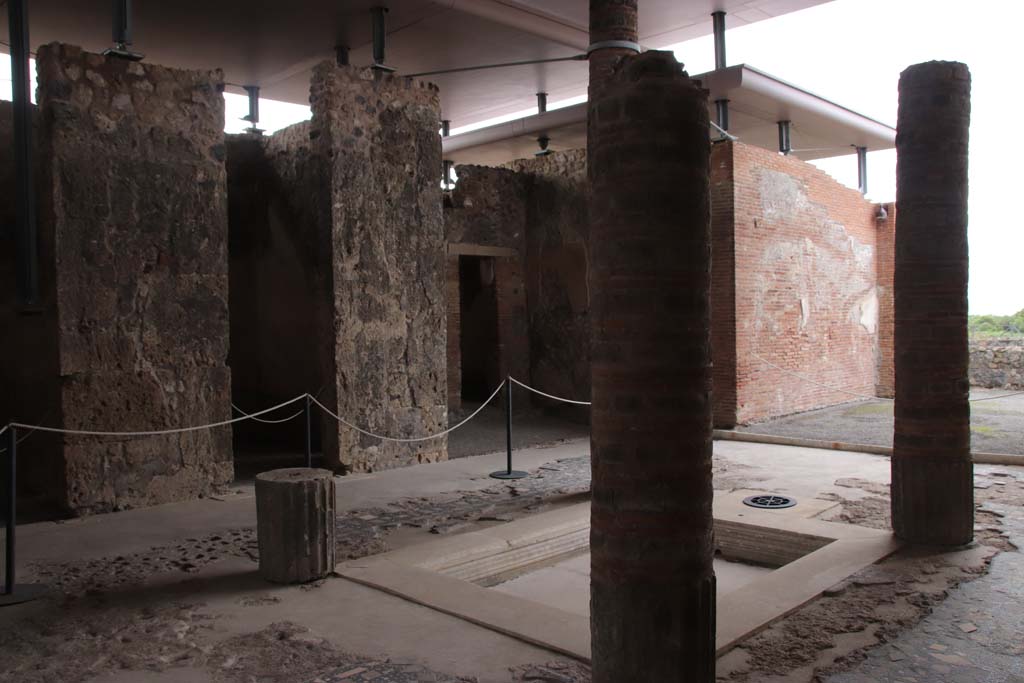
VIII.2.1 Pompeii. October 2020.
Looking south-east across atrium towards east wall
of tablinum, on right. Photo courtesy of Klaus Heese.
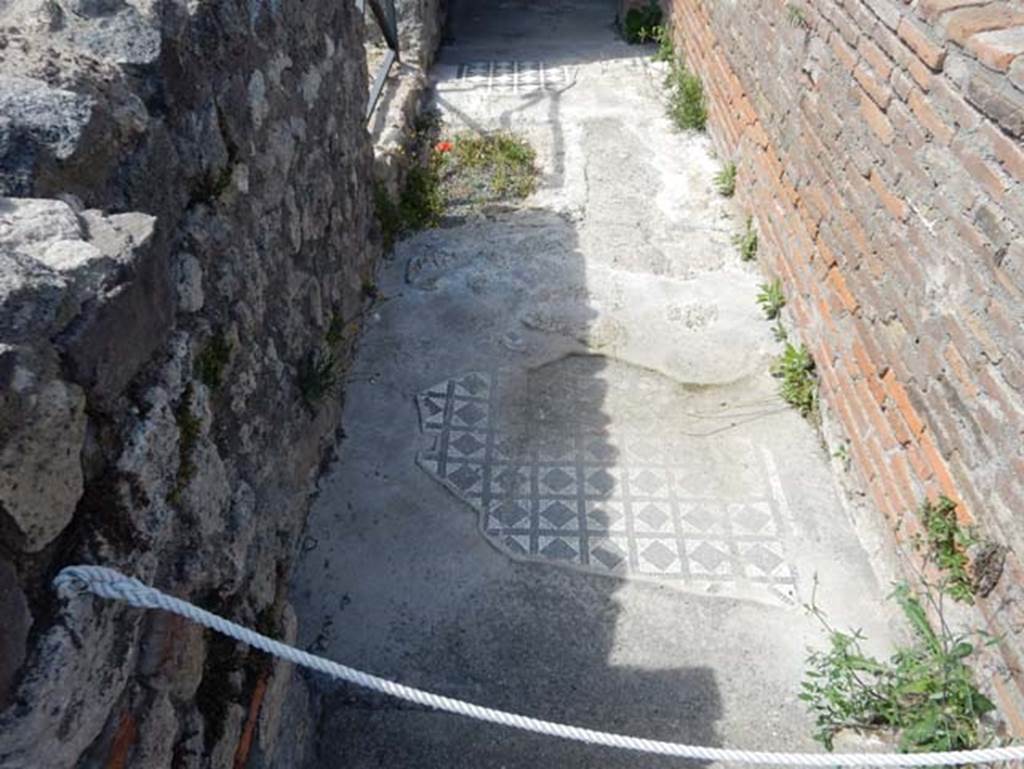
VIII.2.1 Pompeii. May 2018. Looking north along rear of corridor on west side of tablinum. Photo courtesy of Buzz Ferebee.
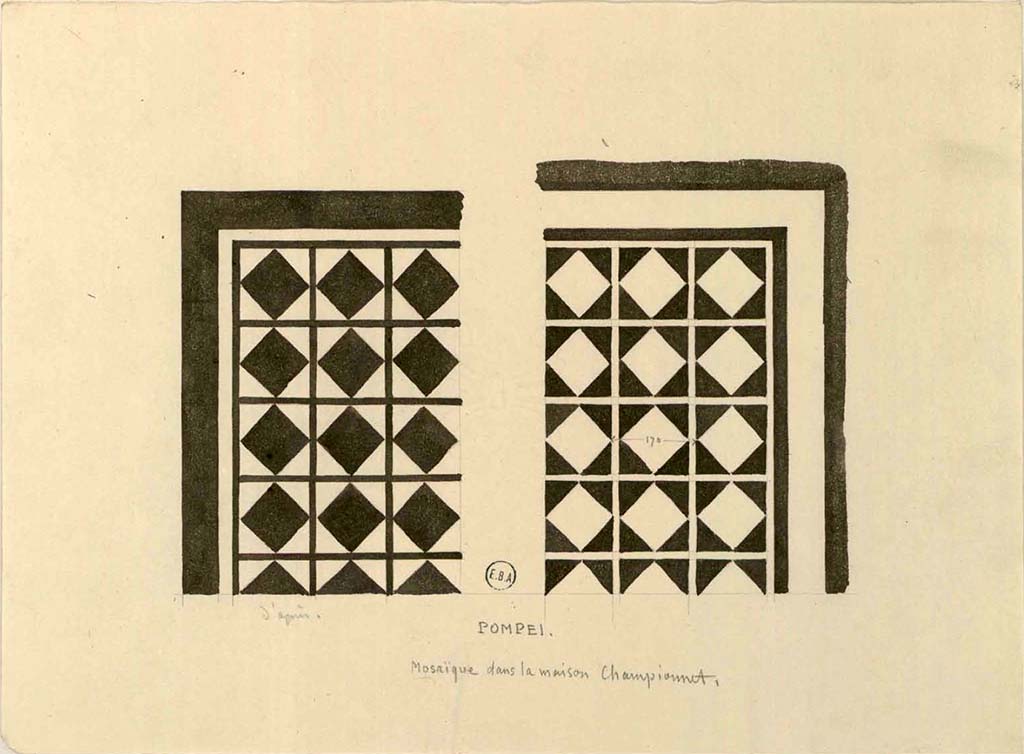
See Lesueur, Jean-Baptiste Ciceron. Voyage en
Italie de Jean-Baptiste Ciceron Lesueur (1794-1883), pl. 48.
See Book on INHA reference INHA NUM PC 15469 (04) « Licence Ouverte / Open Licence » Etalab
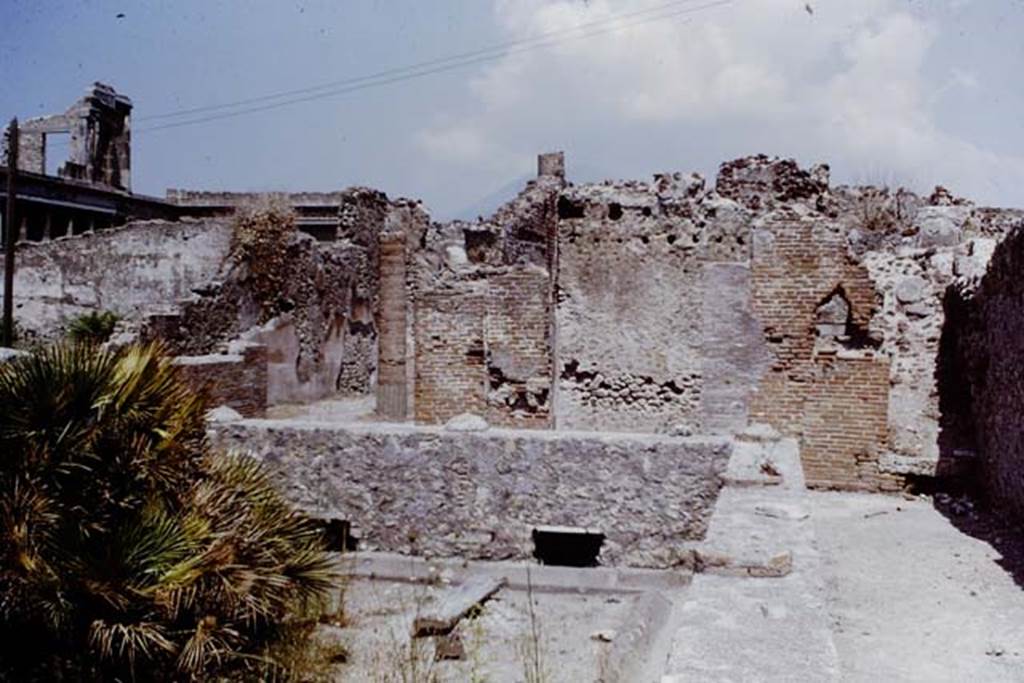
VIII.2.1 Pompeii. 1968. Looking north across peristyle garden towards tablinum, centre left. The corridor on its west, is on the left.
The cubiculum/triclinium can be seen, centre right, together with area in north-east corner, on right. Photo by Stanley A. Jashemski.
Source: The Wilhelmina and Stanley A. Jashemski archive in the University of Maryland Library, Special Collections (See collection page) and made available under the Creative Commons Attribution-Non-Commercial License v.4. See Licence and use details.
J68f1233
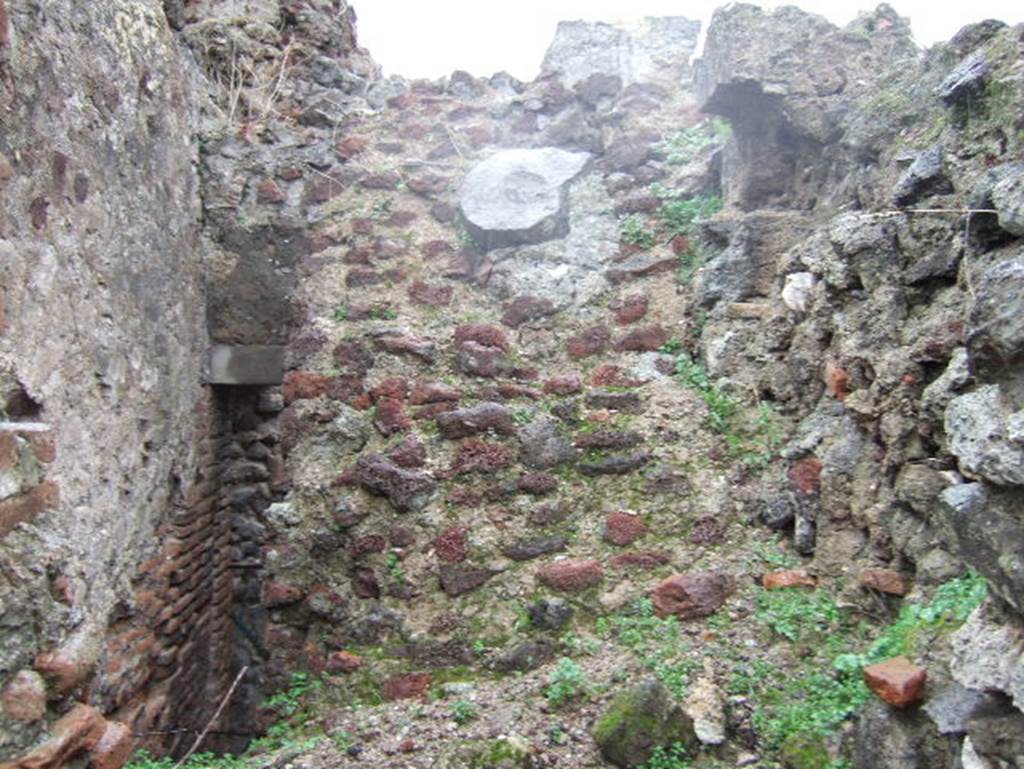
VIII.2.1 Pompeii. December 2005. Area in north-east corner of peristyle garden, looking north.

VIII.2.1 Pompeii. 1968.
Looking towards north side of peristyle garden, and rear of corridor and tablinum, with doorway to cubiculum, on right.
Photo by Stanley A. Jashemski.
Source: The Wilhelmina and Stanley A. Jashemski archive in the University of Maryland Library, Special Collections (See collection page) and made available under the Creative Commons Attribution-Non-Commercial License v.4. See Licence and use details.
J68f1193

VIII.2.1 Pompeii. December 2005.
Looking north. Cubiculum on upper level, without floor on east side of tablinum, and lower room 27.
According to Breton, the cubiculum would have been a beautiful room, when excavated the paintings were nearly all faded.
See Breton, Ernest. 1870. Pompeia, Guide de visite a Pompei, 3rd ed. Paris, Guerin, (p.502).
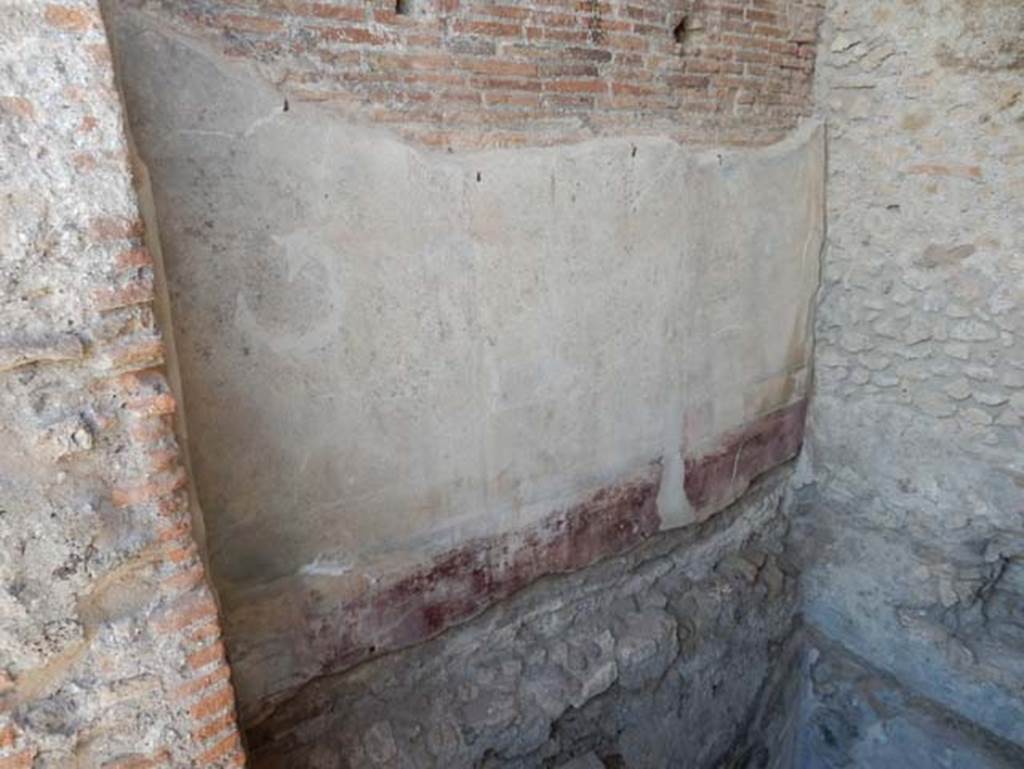
VIII.2.1 Pompeii. May 2018. Looking towards upper west wall of cubiculum, and room 27 below. Photo courtesy of Buzz Ferebee.
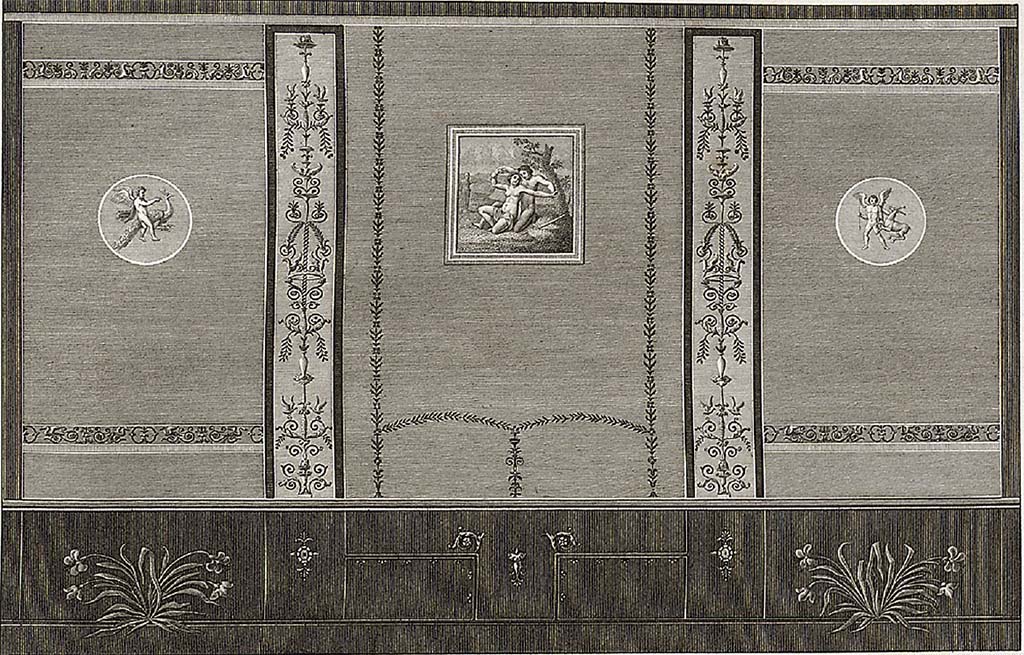
VIII.2.1 Pompeii. 1824 drawing by Mazois of west wall in triclinium, or cubiculum (n in PPP).
See Mazois, F., 1824. Les Ruines de Pompei : Second Partie. Paris: Firmin Didot. (Plate XXIII fig. 1).

VIII.2.1 Pompeii. 1824 drawing by Mazois of cupids on west wall in triclinium, or cubiculum (n in PPP).
See Mazois, F., 1824. Les Ruines de Pompei : Second Partie. Paris: Firmin Didot. (Plate XXIII figs. 2, 3, 4).
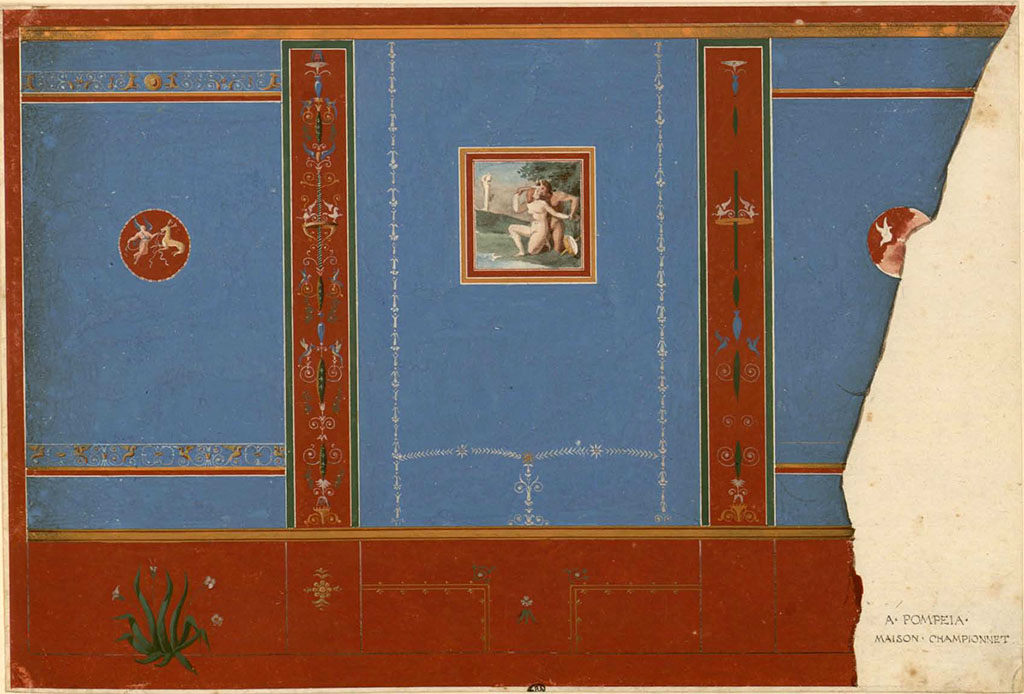
VIII.2.1 Pompeii, described as Maison
Championnet, wall in triclinium, or cubiculum.
See Duban F. Album
de dessins d'architecture effectués par Félix Duban pendant son pensionnat à la
Villa Medicis, entre 1823 et 1828 : Tome 2, Pompéi, pl. 53.
INHA Identifiant numérique NUM PC 40425 (2)
https://bibliotheque-numerique.inha.fr/idurl/1/7157
« Licence Ouverte / Open Licence » Etalab
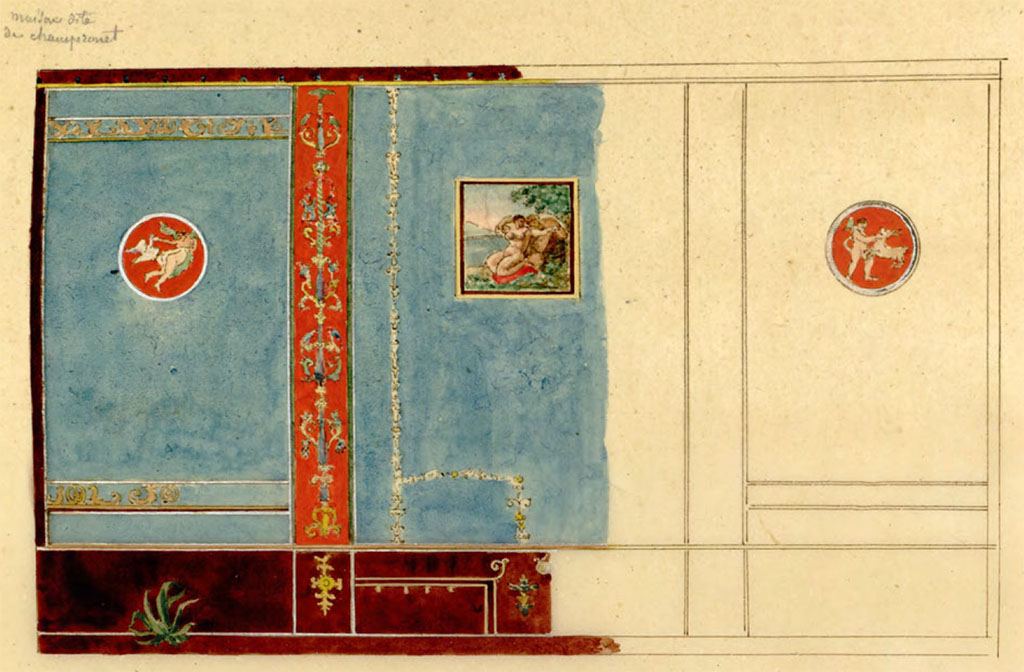
VIII.2.1
Pompeii, c.1817. Watercolour sketch by Chenavard of wall of triclinium, or
cubiculum.
See Chenavard,
Antoine-Marie (1787-1883) et al. Voyage d'Italie, croquis Tome 3, pl. 119.
INHA Identifiant numérique : NUM MS 703 (3). See Book
on INHA
Document placé sous « Licence
Ouverte / Open
Licence » Etalab
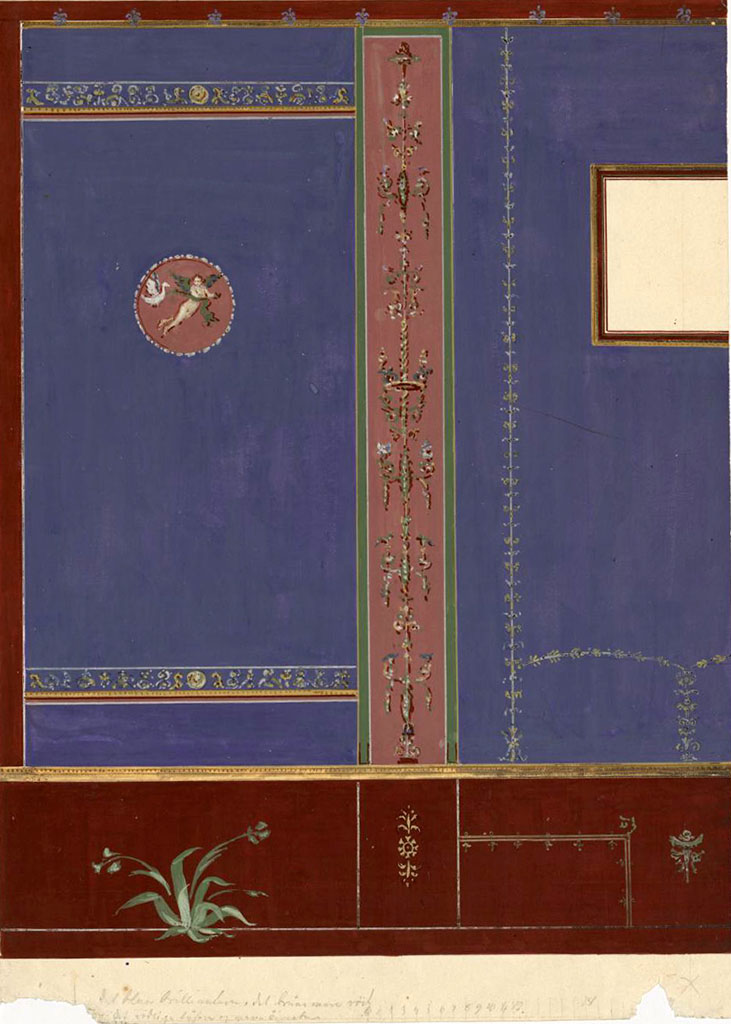
VIII.2.1 Pompeii, painting by Gottlieb Bindesbøll (1800-1856), of
wall in triclinium, or cubiculum.
Photo © Danmarks Kunstbibliotek inv no
ark_16099-100.
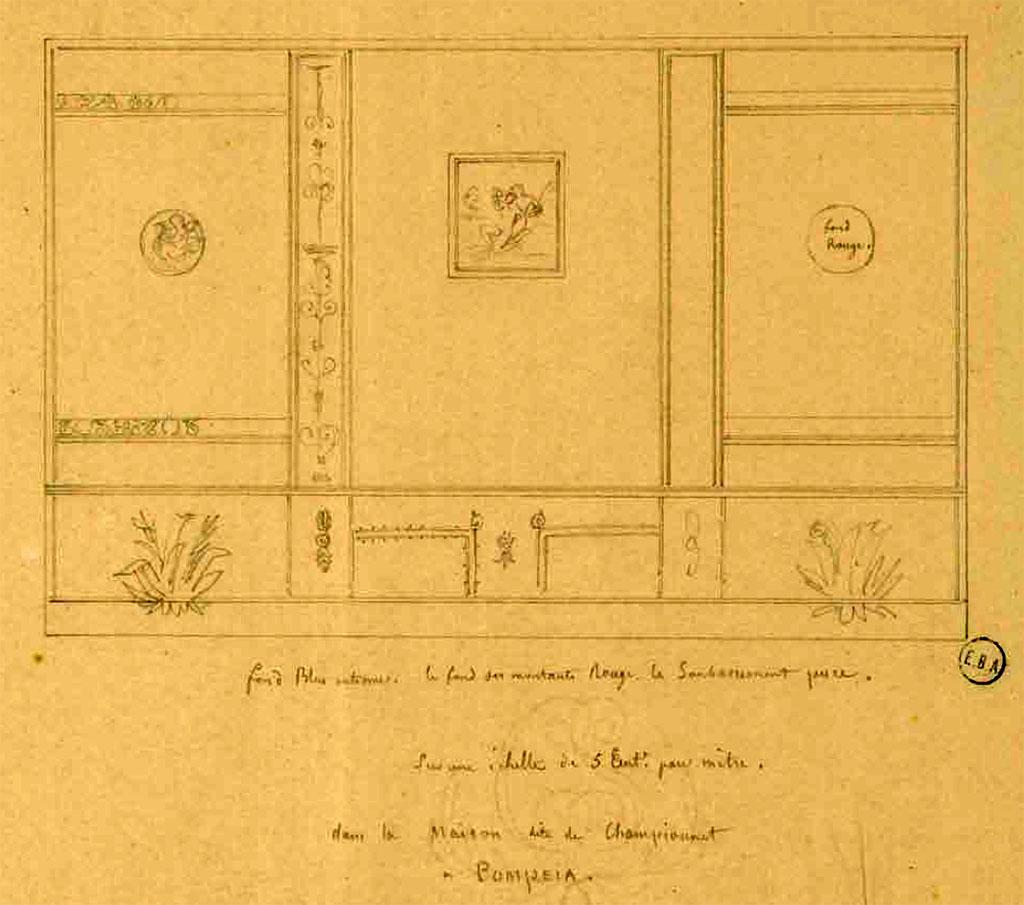
VIII.2.1 Pompeii. Drawing of west wall of triclinium/cubiculum.
See
Lesueur, Jean-Baptiste Ciceron. Voyage en Italie de Jean-Baptiste Ciceron
Lesueur (1794-1883), pl. 78.
See Book on INHA reference INHA NUM PC 15469 (04) « Licence Ouverte / Open Licence » Etalab
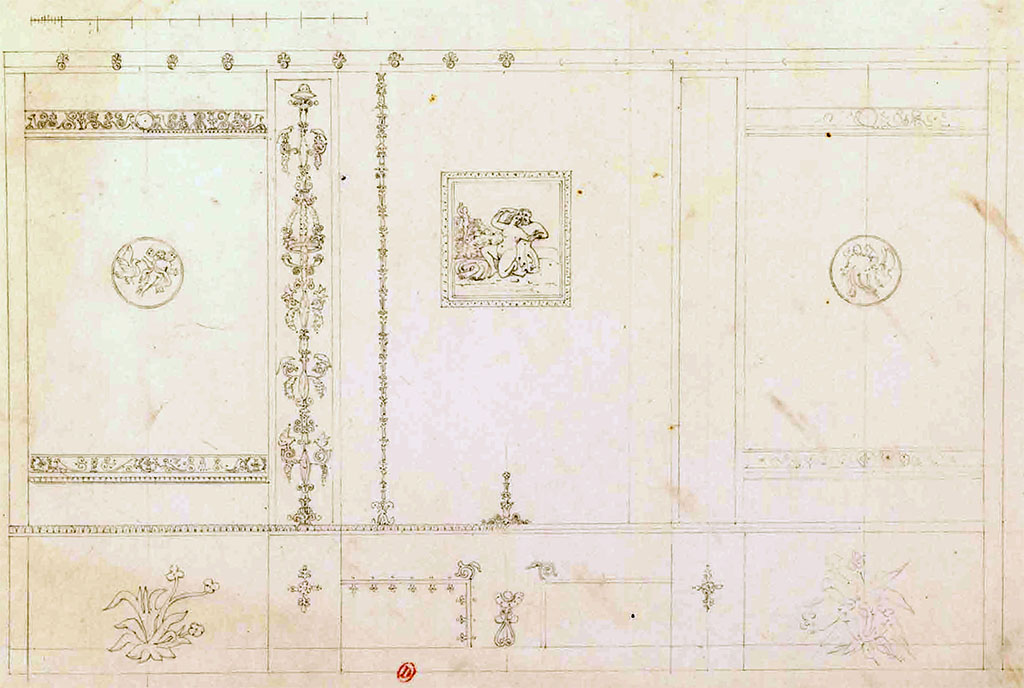
VIII.2.1 Pompeii. July 1826. Drawing of west
wall of triclinium/cubiculum, by P.A. Poirot.
See Poirot, P. A., 1826. Carnets
de dessins de Pierre-Achille Poirot. Tome 2 : Pompeia, pl. 39.
See Book
on INHA Document
placé sous « Licence Ouverte
/ Open Licence »
Etalab
![VIII.2.1 Pompeii. Between 1819 and 1832, drawing by W. Gell of detail of decoration from west wall of triclinium, or cubiculum (n in PPP).
See Gell, W. Pompeii unpublished [Dessins de l'édition de 1832 donnant le résultat des fouilles post 1819 (?)] vol II, pl. 19.
Bibliothèque de l'Institut National d'Histoire de l'Art, collections Jacques Doucet, Identifiant numérique Num MS180 (2).
See book in INHA Use Etalab Licence Ouverte](8%2002%2001%20p3_files/image034.jpg)
VIII.2.1 Pompeii.
Between 1819 and 1832, drawing by W. Gell of detail of decoration from west wall of triclinium, or cubiculum (room n in PPP).
See Gell, W. Pompeii unpublished [Dessins de
l'édition de 1832 donnant le résultat des fouilles post 1819 (?)] vol II, pl.
19.
Bibliothèque de l'Institut National d'Histoire de
l'Art, collections Jacques Doucet, Identifiant numérique Num MS180 (2).
See book in INHA Use Etalab Licence Ouverte
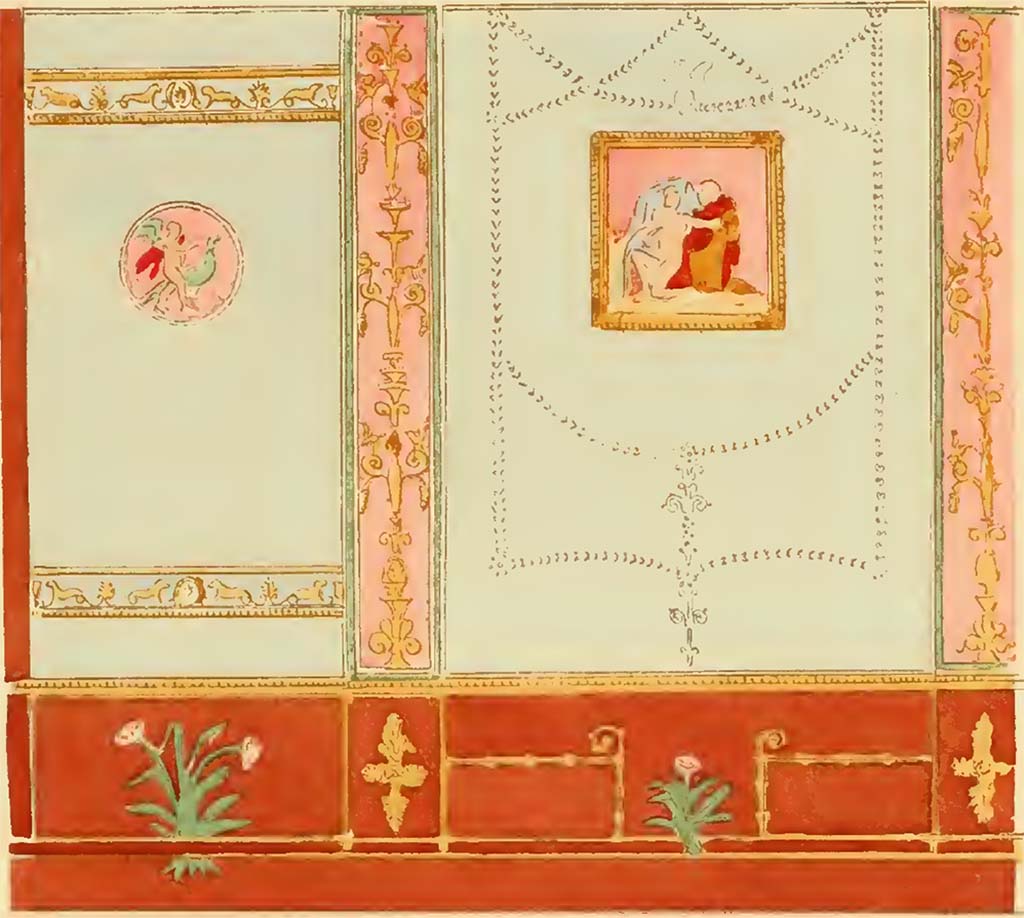
VIII.2.1 Pompeii. Painting by Gusman of west wall in triclinium, or cubiculum
(XXI. 2° Panneau extrait des originaux de
l'architecte Mazois.)
See Gusman P., 1924. La Décoration Murale de
Pompei. Paris : Morancé, pl. XXI,2.
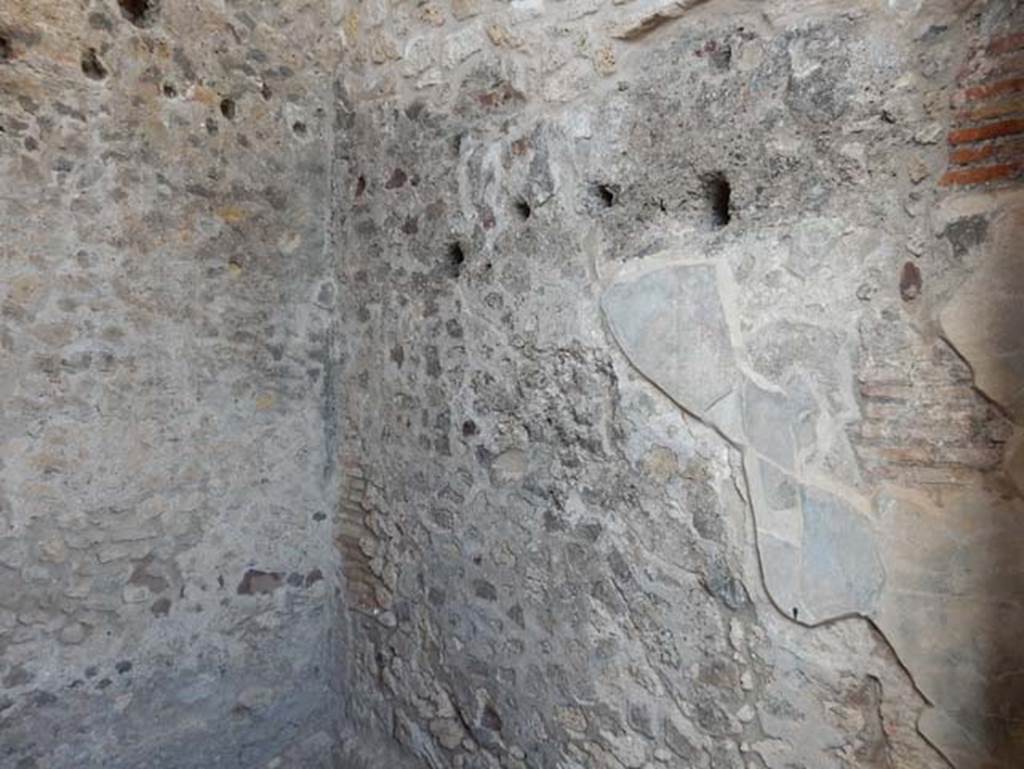
VIII.2.1 Pompeii. May 2018. Looking towards upper east wall of cubiculum, above room 27. Photo courtesy of Buzz Ferebee.
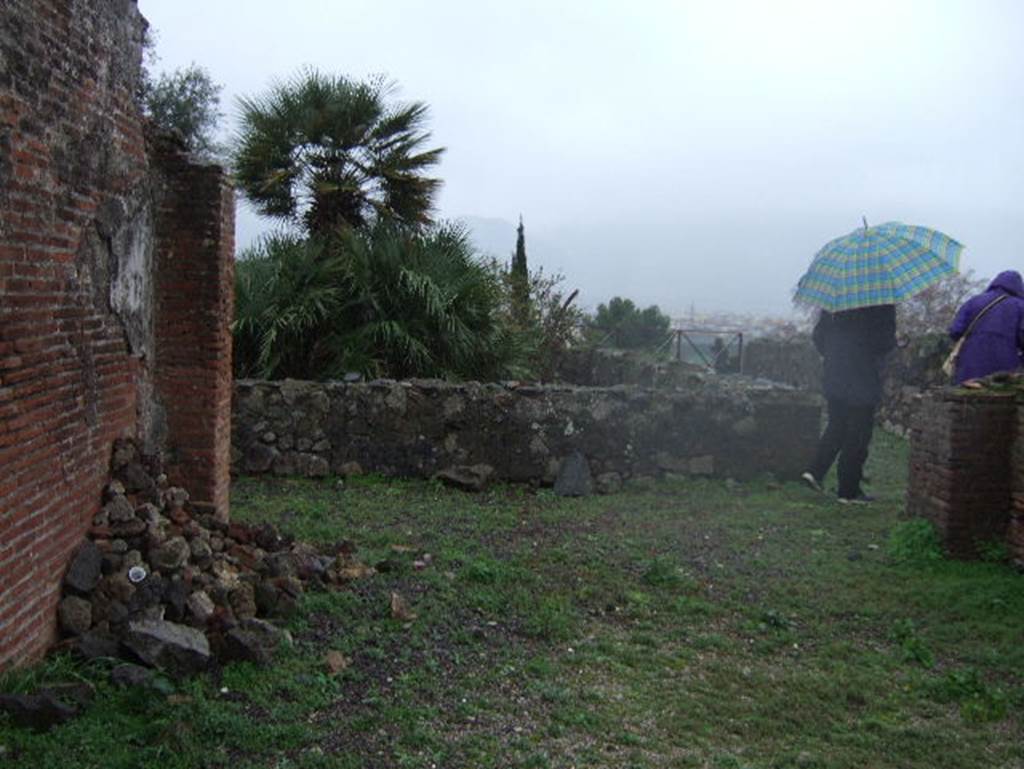
VIII.2.1 Pompeii. December 2005. Looking south across tablinum to peristyle garden.
According to Breton –
“At the rear of the peristyle was an oecus “t”, two passageways “u” rising up slightly to a terrace “v” looking over the port and sea, a lararium “x”, and a small area “z” nearby to this. Of these constructions, there are almost no traces left, the vaults of the rooms below on which they rested, have mostly fallen.”
See Breton, Ernest.
1855. Pompeia, decrite et dessine :
Seconde édition. Paris, Baudry, (p.342).
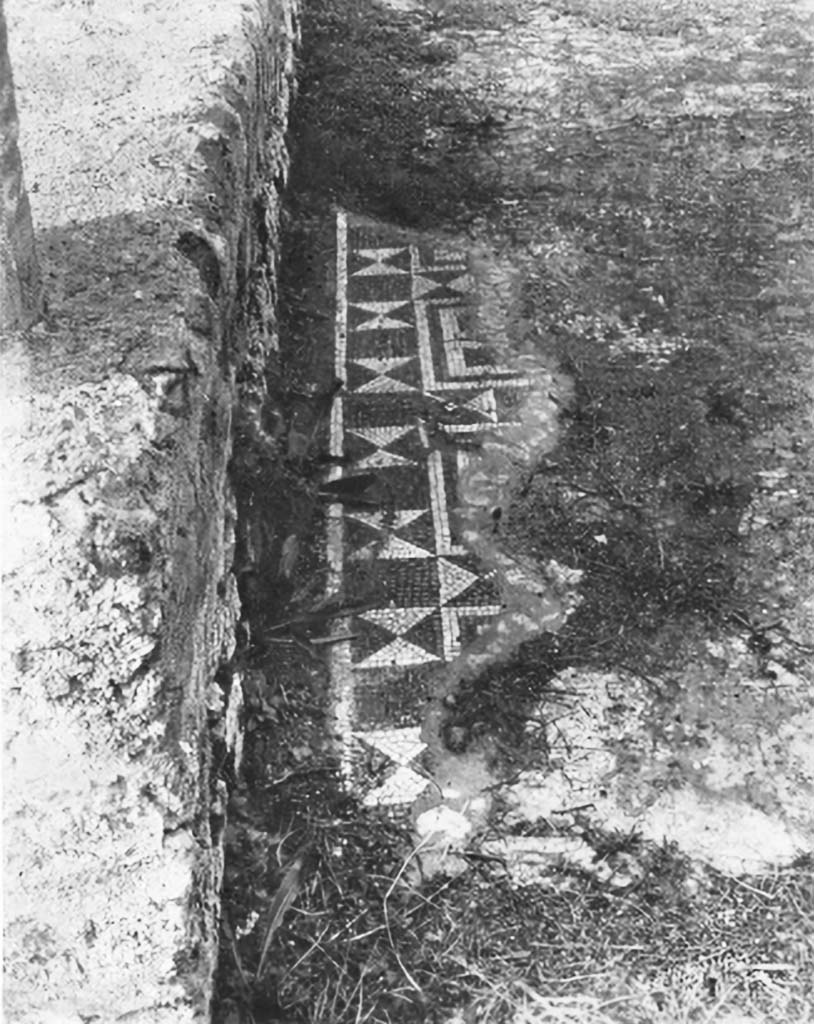
VIII.2.1 Pompeii. c.1930. Mosaic flooring of
peristyle.
According to Blake –
In the tablinum, the border was a band of
squares set diagonally:
in the peristyle, of squares of plain black
alternating with squares composed of four triangles.
See Blake, M., (1930). The pavements of the
Roman Buildings of the Republic and Early Empire. Rome, MAAR, 8, (p.
98,110, & Pl.24, tav.1).
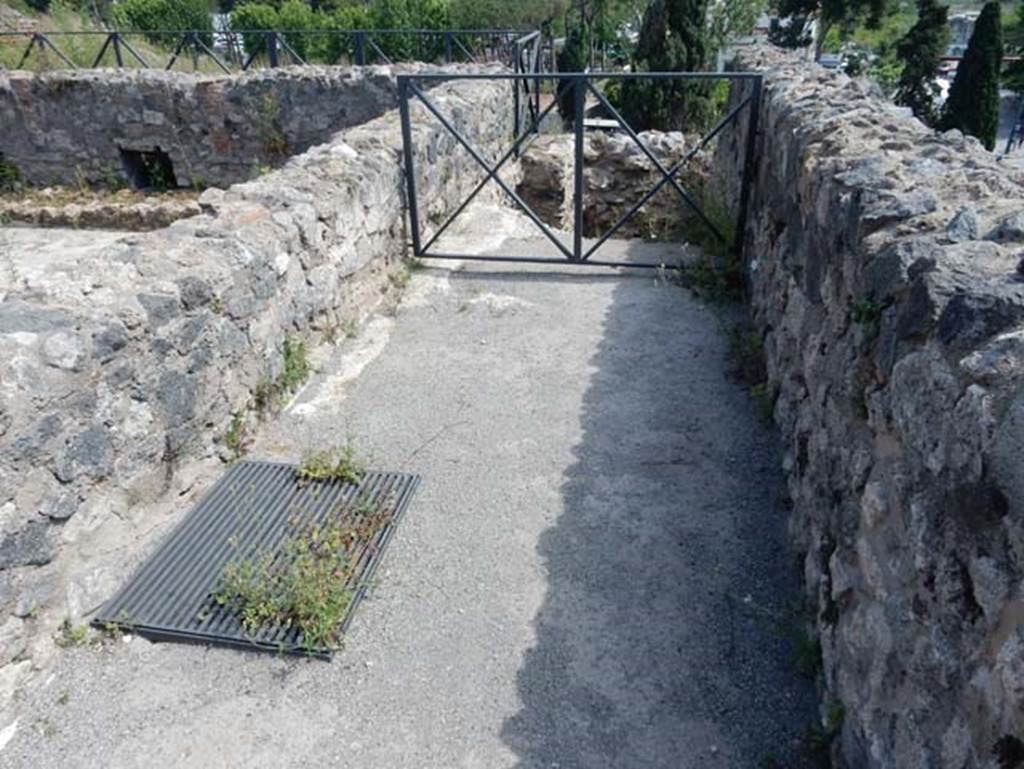
VIII.2.1 Pompeii. May 2018. Looking south along west side of peristyle garden. Photo courtesy of Buzz Ferebee.
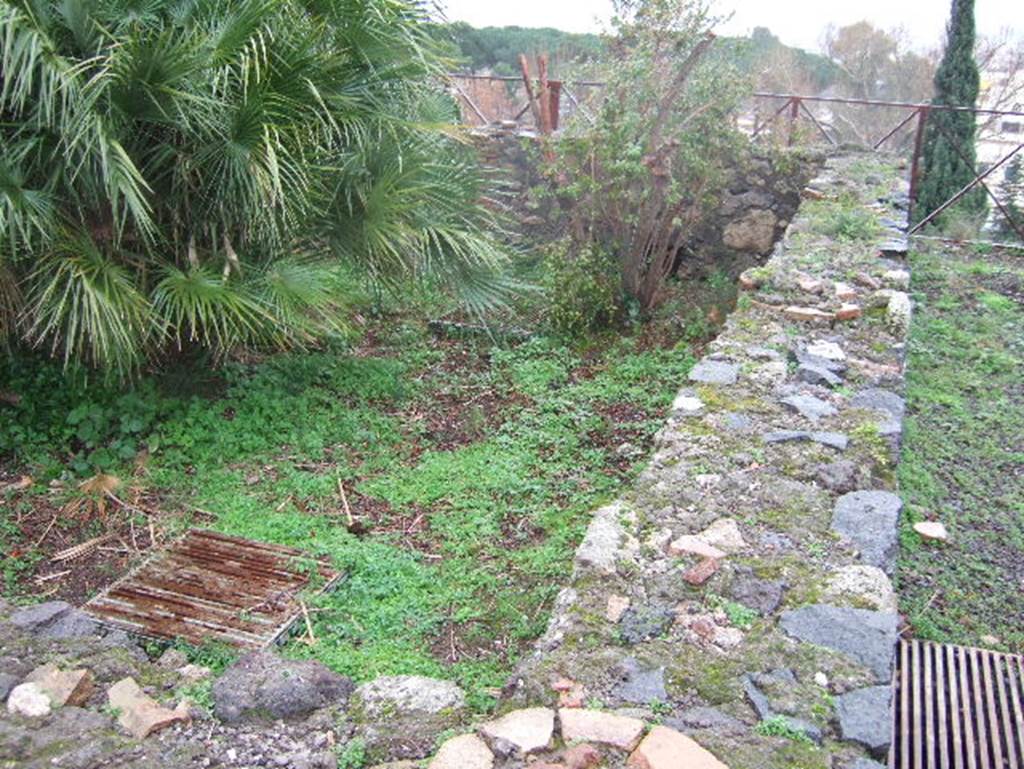
VIII.2.1 Pompeii. December 2005. Looking south along west side of peristyle garden.
According to Jashemski, the peristyle garden at the rear of the tablinum was excavated in 1799.
It was enclosed on four sides by a portico supported by twelve brick columns.
It was called a hanging garden by Mazois and Fiorelli, because it was built on the volcanic ledge.
To give light to the rooms below, openings were cut in the floor which supported the columns.
Around the edges of the garden was a gutter.
There was a fine view over the Bay and the mountains from the terraces on two levels at the rear of the house.
See Jashemski, W. F., 1993. The Gardens of Pompeii, Volume II: Appendices. New York: Caratzas. (p.205).
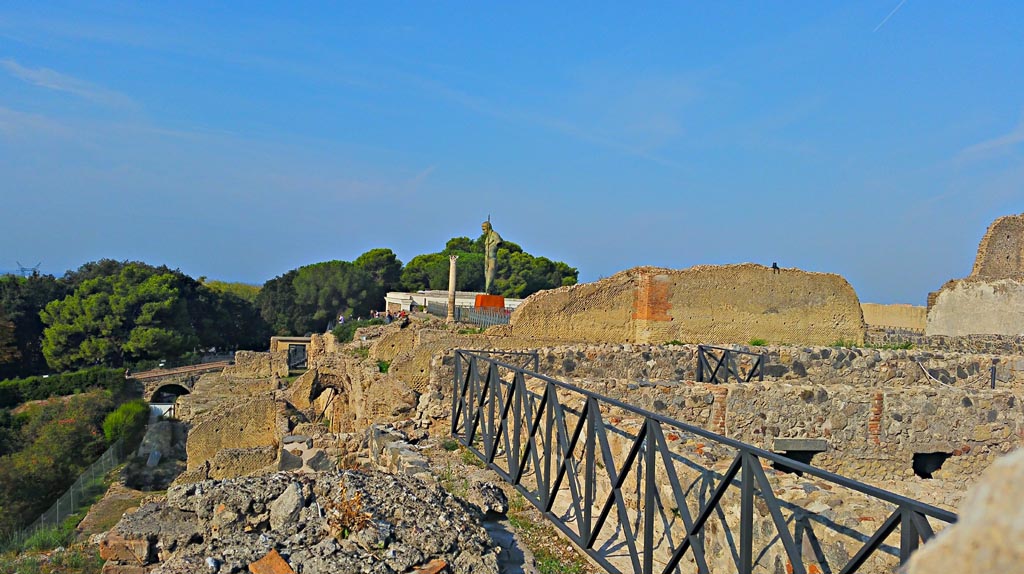
VIII.2.1 Pompeii. 2017/2018/2019.
Looking west from VIII.2.1, lower and right, towards VIII.2.A across
centre, towards Temple of Venus. Photo
courtesy of Giuseppe Ciaramella.
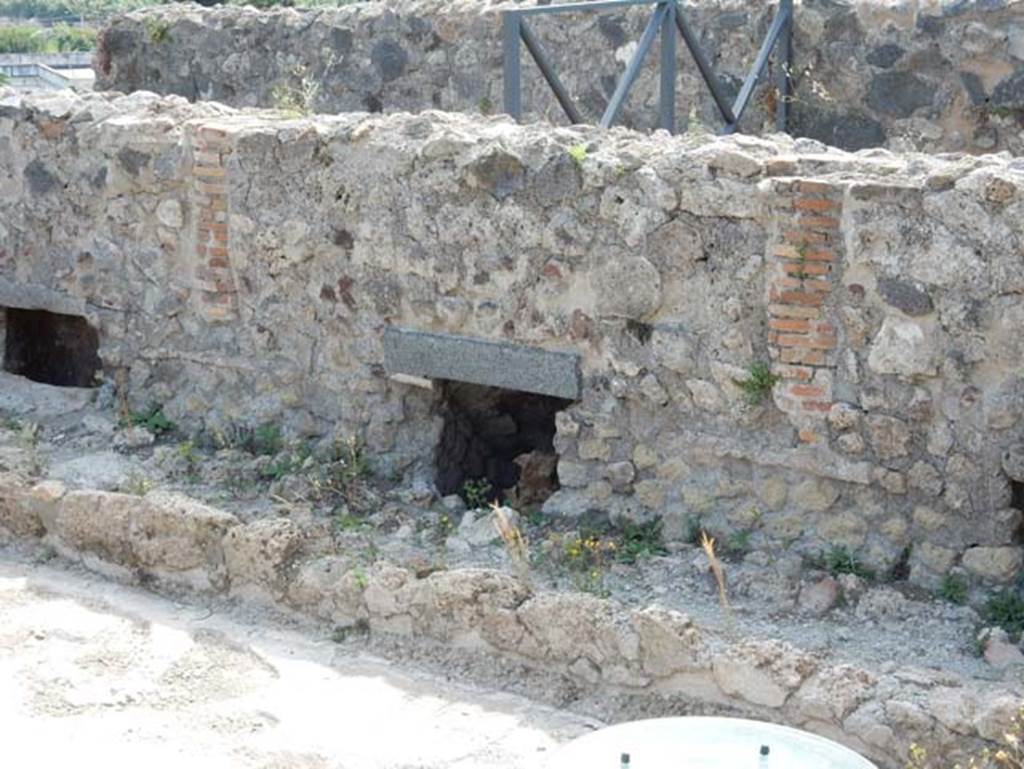
VIII.2.1 Pompeii. May 2018.
Looking towards central window lighting west corridor on lower floor and west side of peristyle garden. Photo courtesy of Buzz Ferebee.
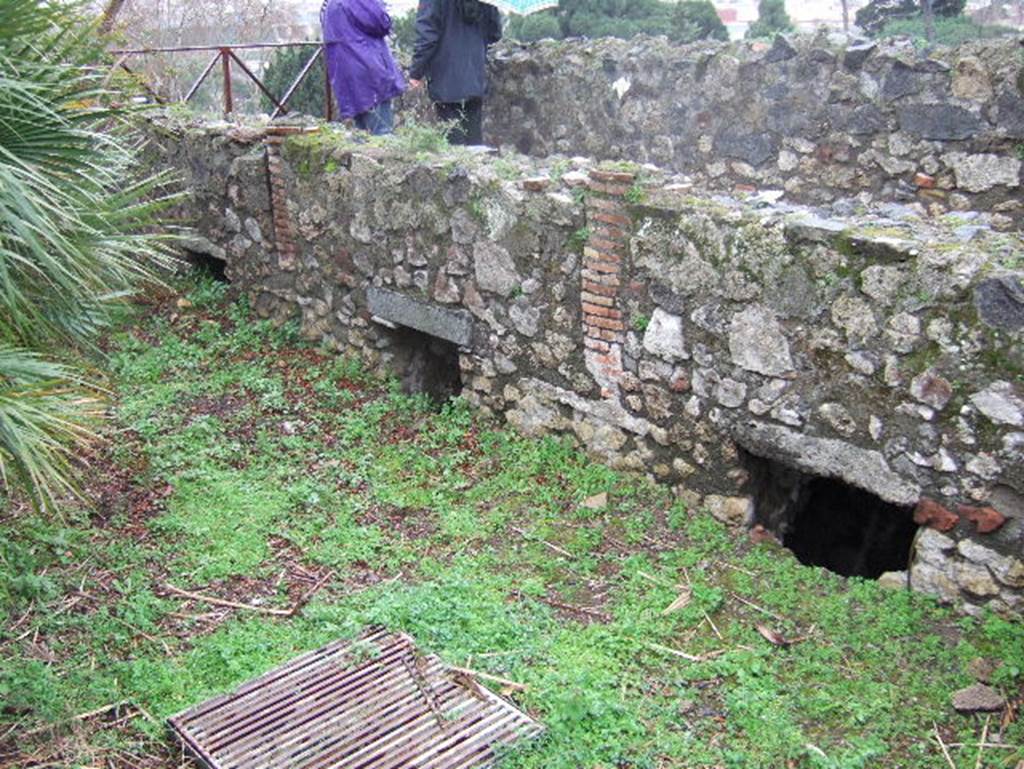
VIII.2.1 Pompeii. December 2005. Looking south-west across garden area.
In order to give light to the rooms below, openings were cut in the floor which supported the columns.
See Jashemski, W. F., 1993. The Gardens of Pompeii, Volume II: Appendices. New York: Caratzas. (p.205)
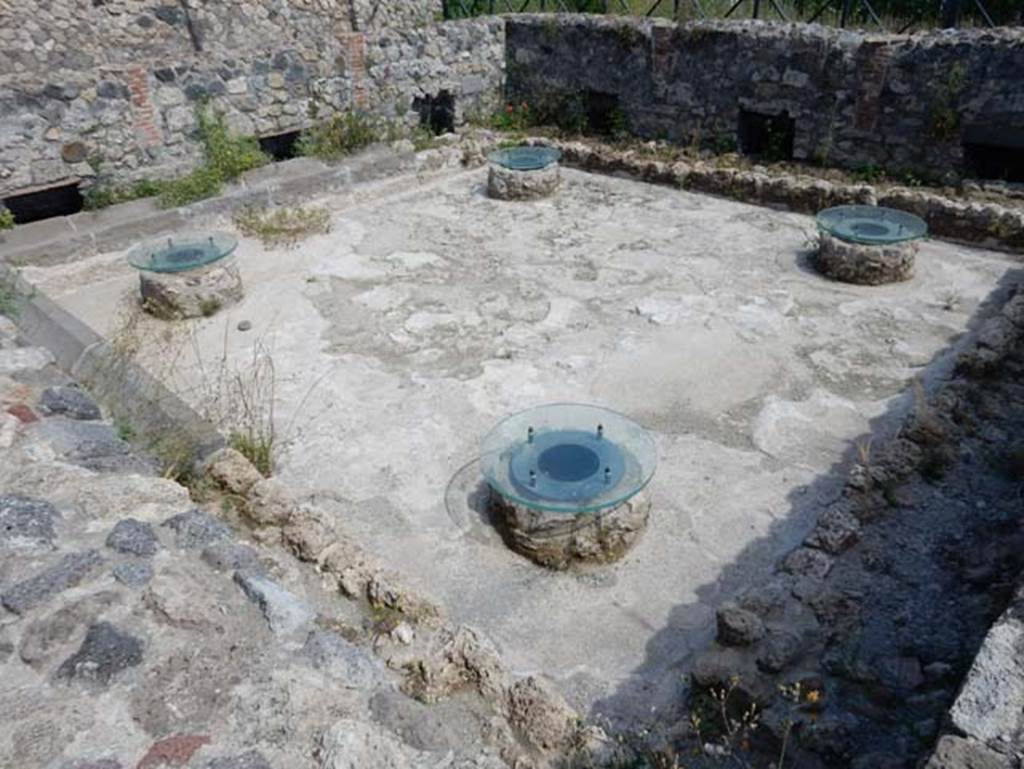
VIII.2.1 Pompeii. May 2018. Looking across to the south-east corner of peristyle garden. Photo courtesy of Buzz Ferebee.
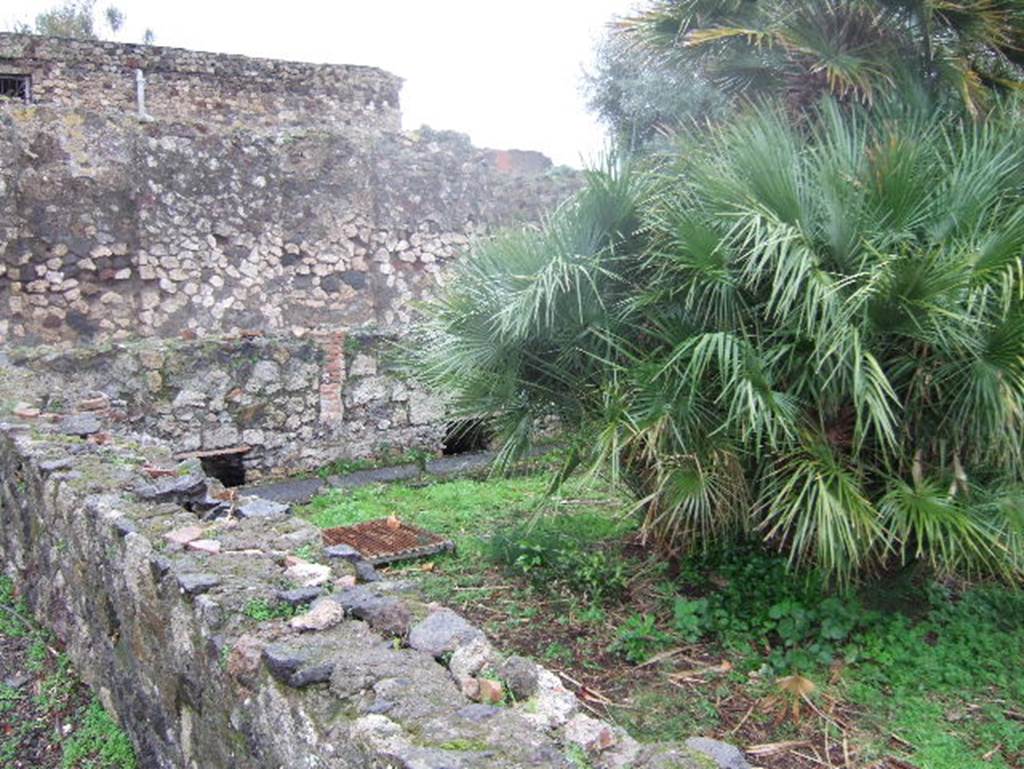
VIII.2.1 Pompeii. December 2005. Looking towards east side of peristyle garden.
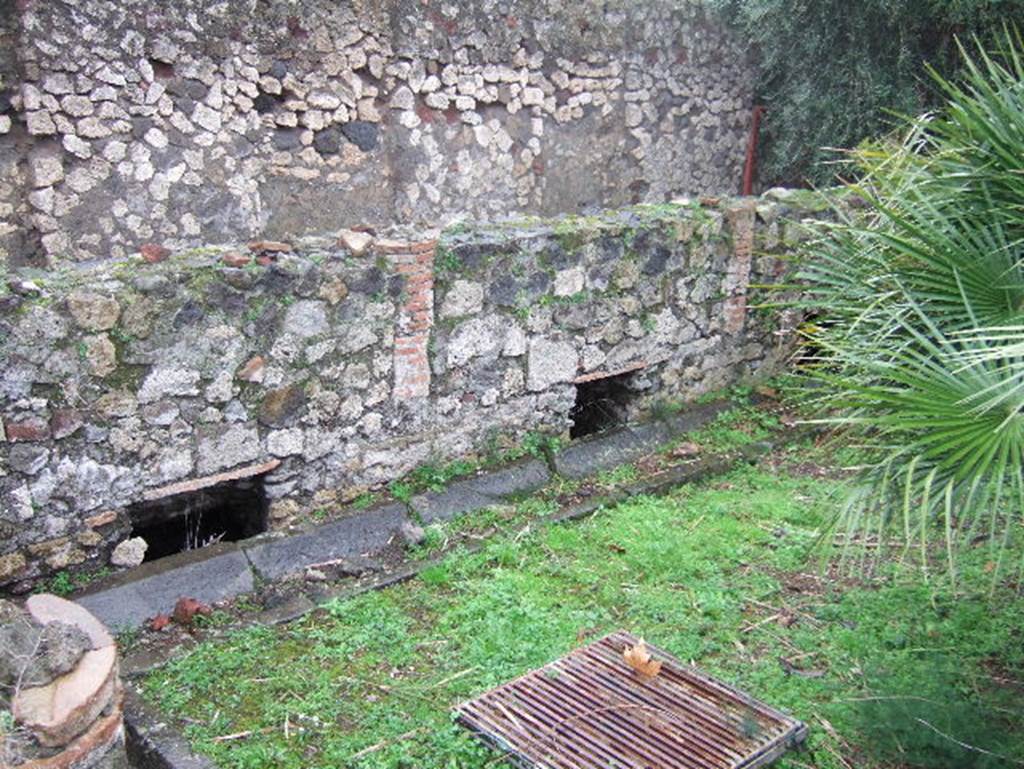
VIII.2.1 Pompeii. December 2005. Looking towards east side of garden area.
In order to give light to the rooms below, openings were cut in the floor which supported the columns.
Around the edges of the garden was a gutter.
See Jashemski, W. F., 1993. The Gardens of Pompeii, Volume II: Appendices. New York: Caratzas. (p.205)
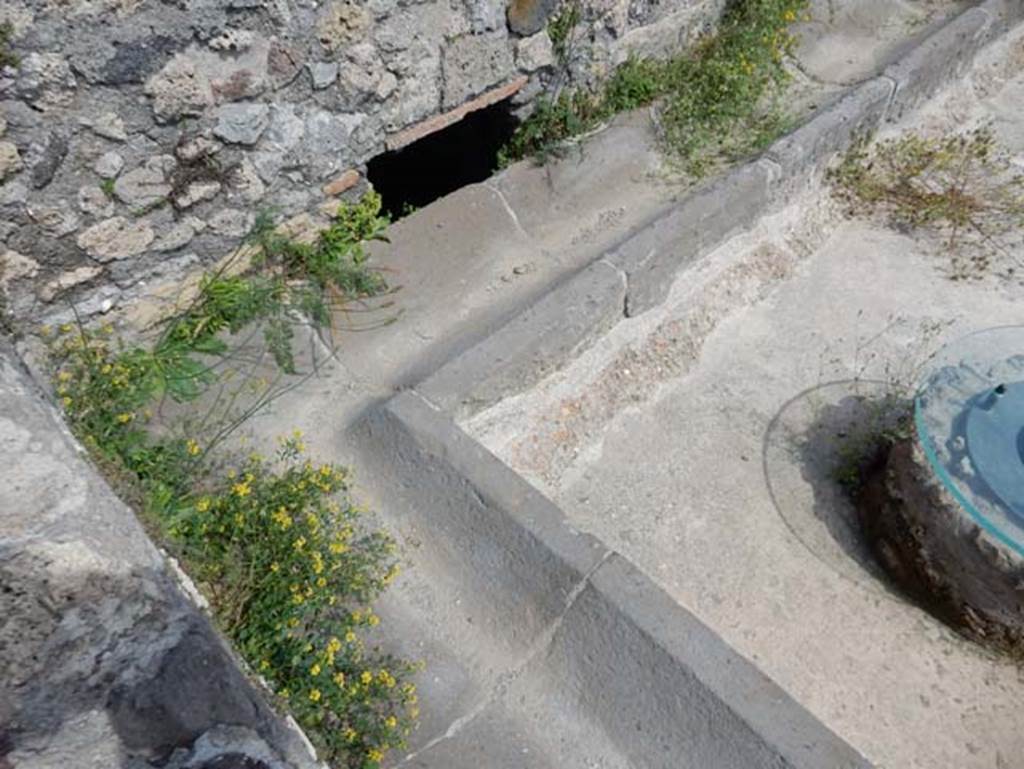
VIII.2.1 Pompeii. May 2018. North-east corner of peristyle garden. Photo courtesy of Buzz Ferebee.
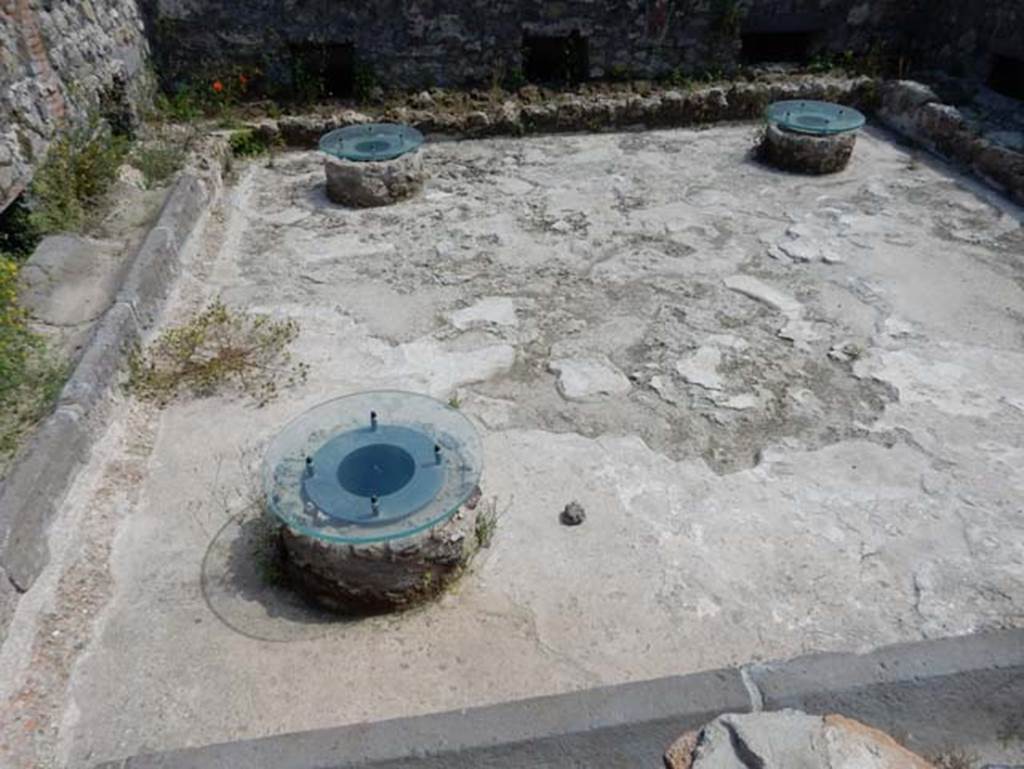
VIII.2.1 Pompeii. May 2018. Looking south across peristyle garden. Photo courtesy of Buzz Ferebee.
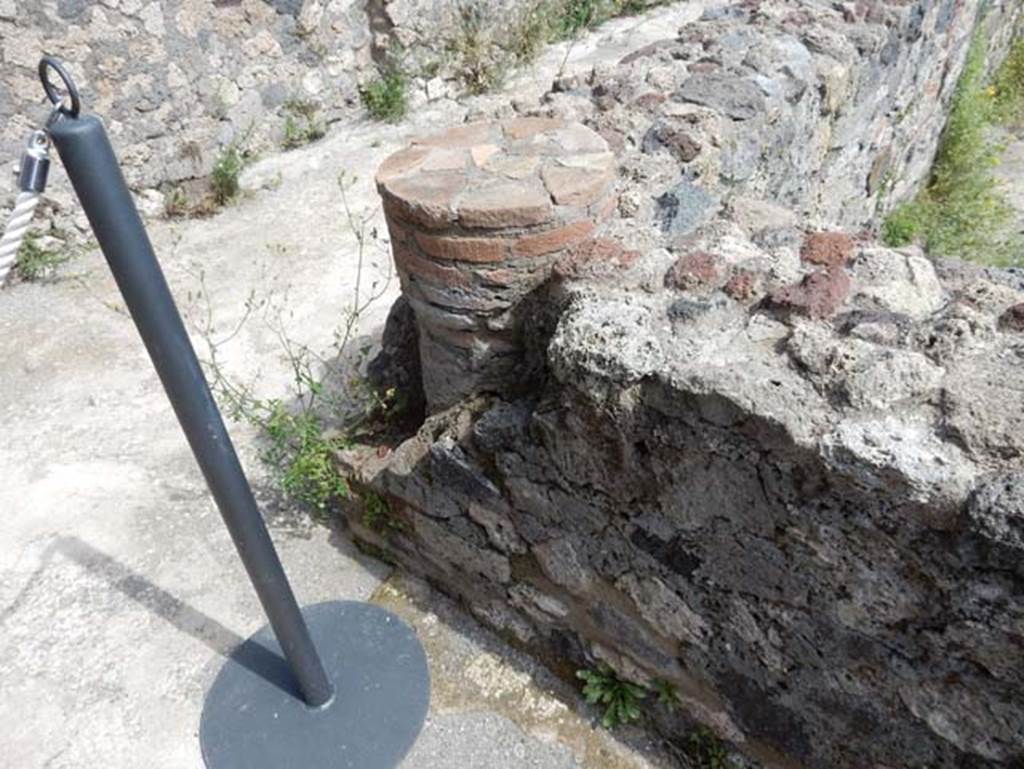
VIII.2.1 Pompeii. May 2018. North-east corner of peristyle garden. Photo courtesy of Buzz Ferebee.
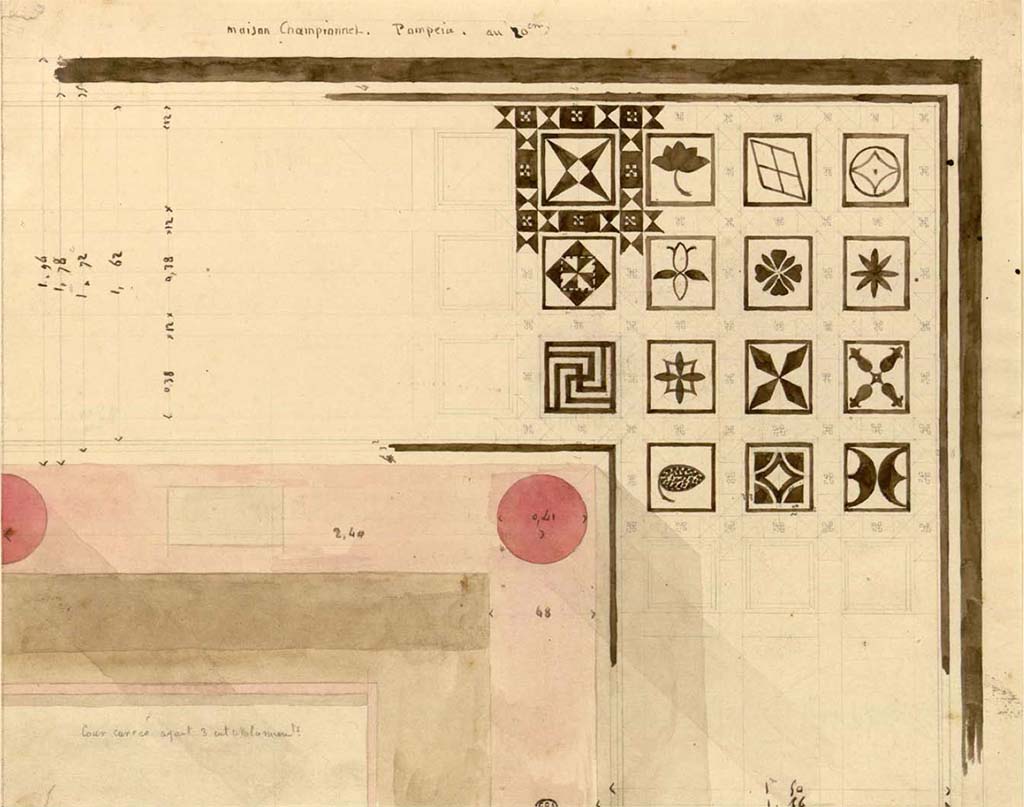
VIII.2.1 Pompeii.
Between 1823 and 1828, drawing showing beautiful mosaic found in the north-east corner of the peristyle garden, now lost.
INHA Identifiant numérique NUM PC 40425 (2)
https://bibliotheque-numerique.inha.fr/idurl/1/7157
« Licence Ouverte / Open Licence » Etalab
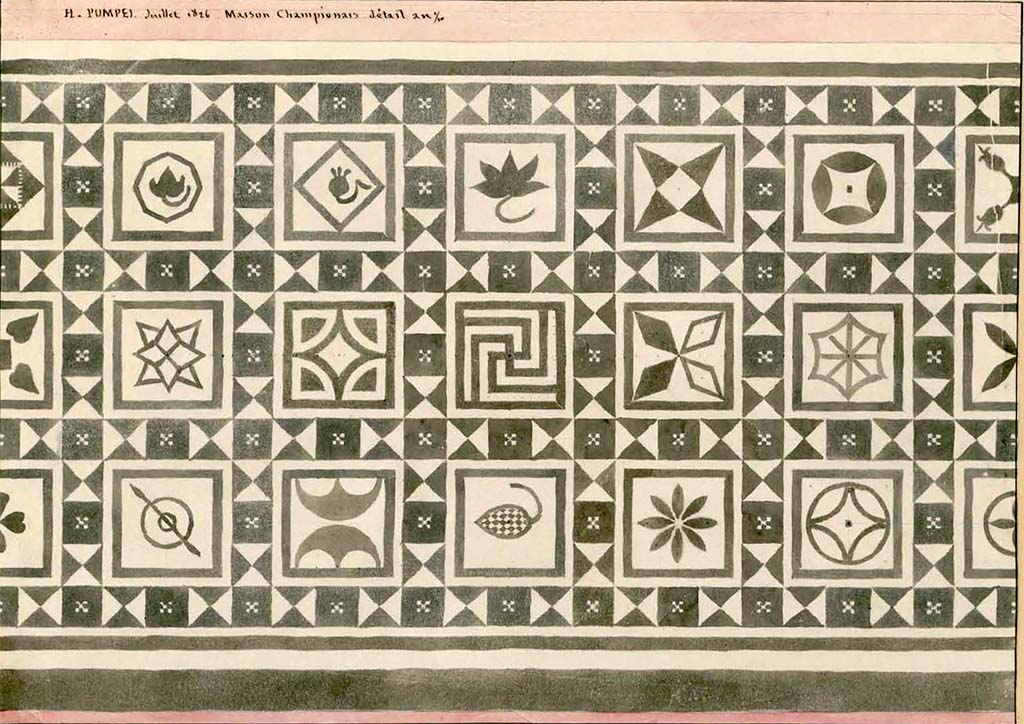
VIII.2.1 Pompeii. July 1826. Mosaic
flooring, painting by P. A. Poirot.
See
Poirot, P. A., 1826. Carnets de dessins de Pierre-Achille Poirot.
Tome 2 : Pompeia, pl. 38 H.
See
Book on INHA
Document placé sous « Licence Ouverte / Open Licence » Etalab
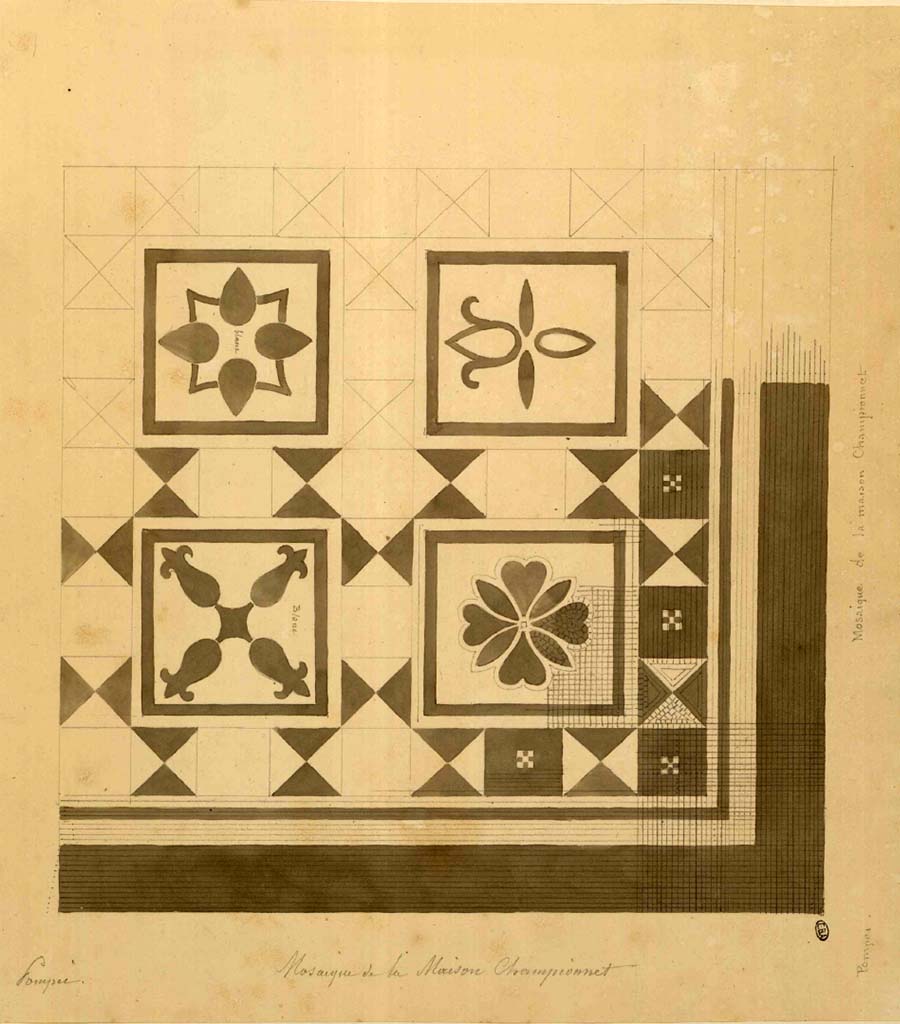
VIII.2.1 Pompeii. Mosaic flooring from
peristyle, drawing by Jacques Hittorff.
See Hittorff,
Jacques Ignace (1792-1867). Carnet de dessins (14), pl. 2.
See Book on INHA reference INHA NUM PC 43236 « Licence Ouverte / Open Licence » Etalab
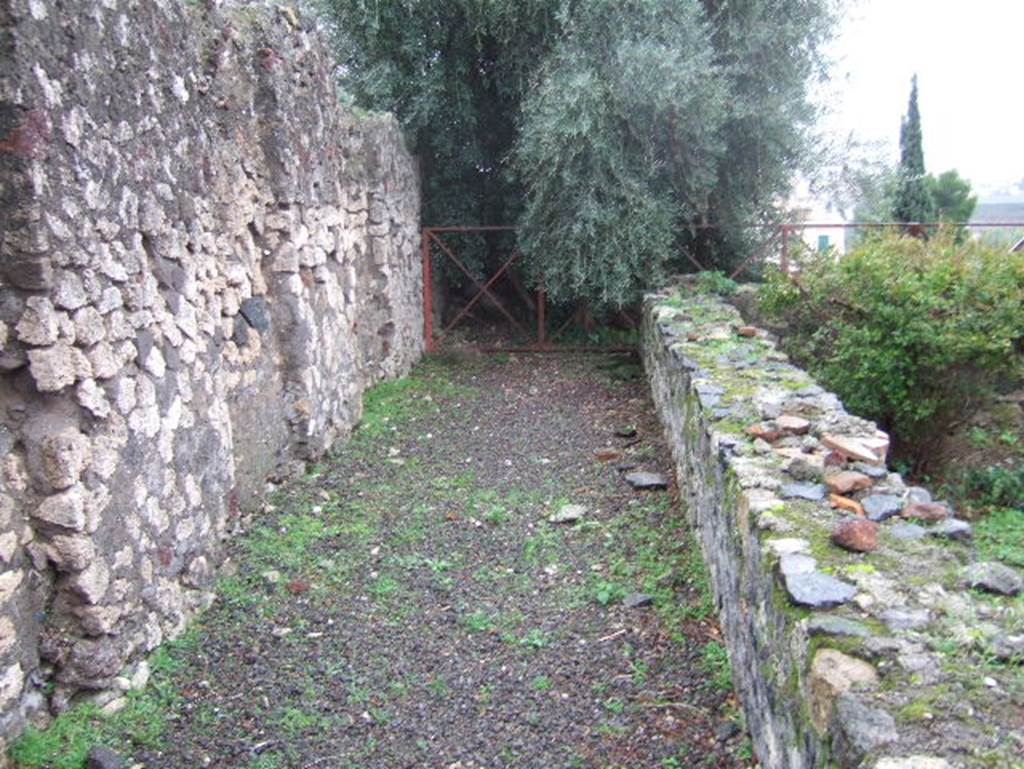
VIII.2.1 Pompeii. December 2005. Looking south along east side of peristyle garden.
According to Boyce, off the south portico of the peristyle opened a sacrarium.
See Boyce G. K., 1937. Corpus of the Lararia of Pompeii. Rome: MAAR 14. (p.74, no.341)
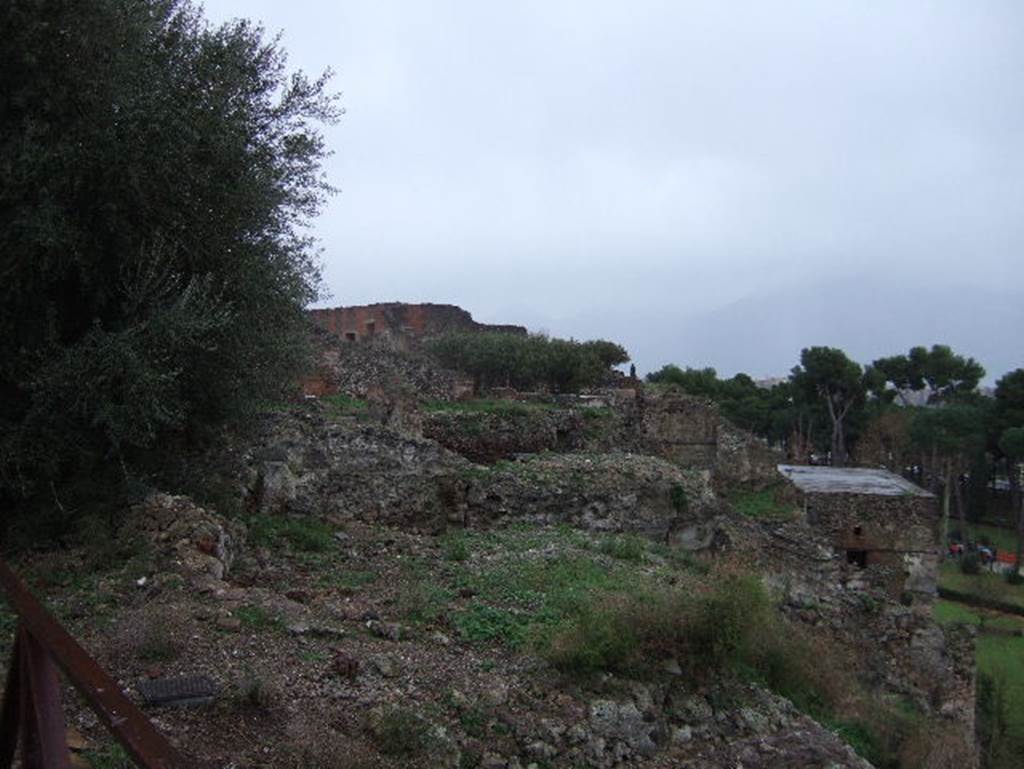
VIII.2.1 Pompeii. December 2005. Looking east from south portico towards VIII.2.3, VIII.2.14, VIII.2.16
The area on the left of the photo would have been the approximate area of the sacrarium.
The south portico is the limit of the present upper (ground or street level) floor, and all rooms to the south have collapsed.
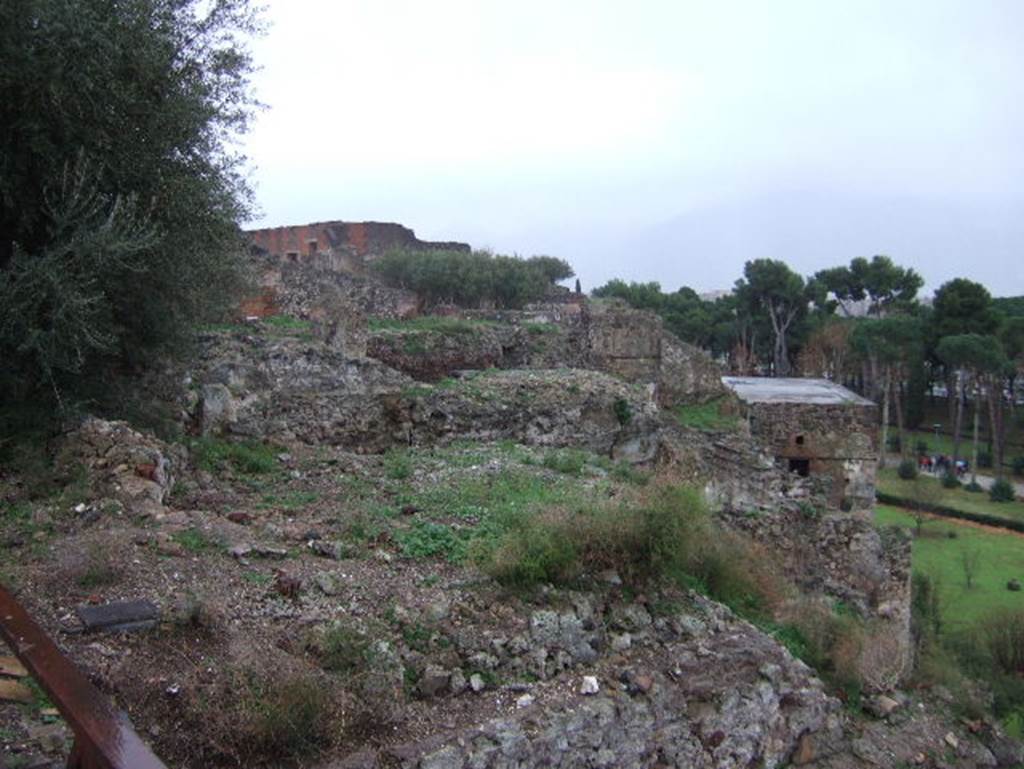
VIII.2.1 Pompeii. December 2005. Looking east at VIII.2.3, VIII.2.14, VIII.2.16.
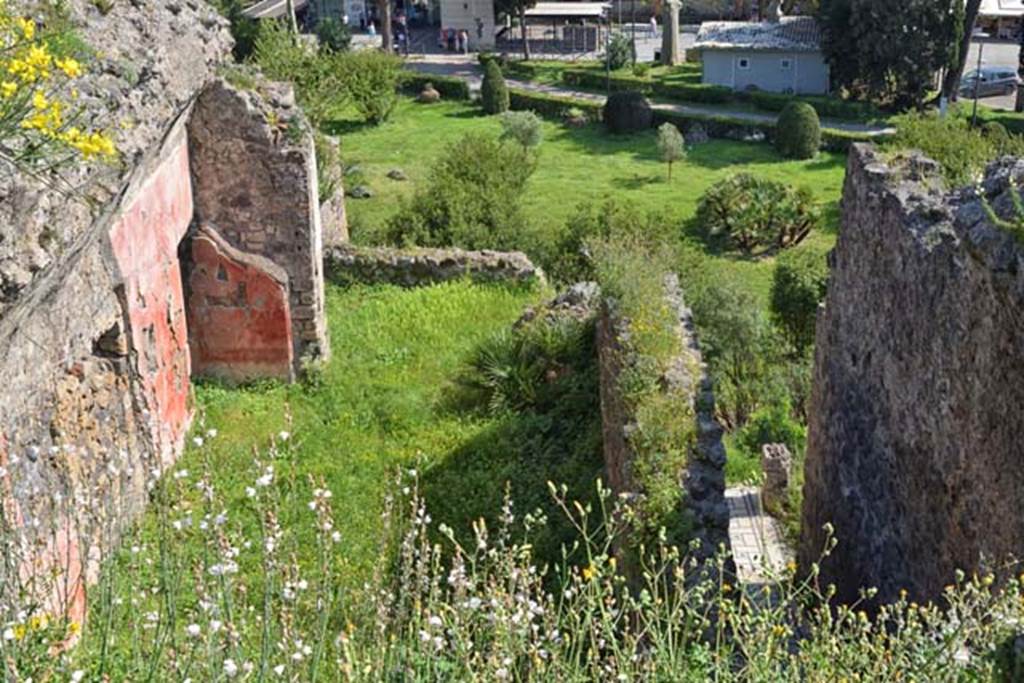
VIII.2.1 Pompeii, on right. April 2018.
Looking south towards triclinium on the lower level of VIII.2.3/VIII.2.16 (?), with corridor 38 or (α), on lower level 1 belonging to VIII.2.1. on right.
Photo
courtesy of Ian Lycett-King.
Use
is subject to Creative Commons Attribution-NonCommercial
License v.4 International.
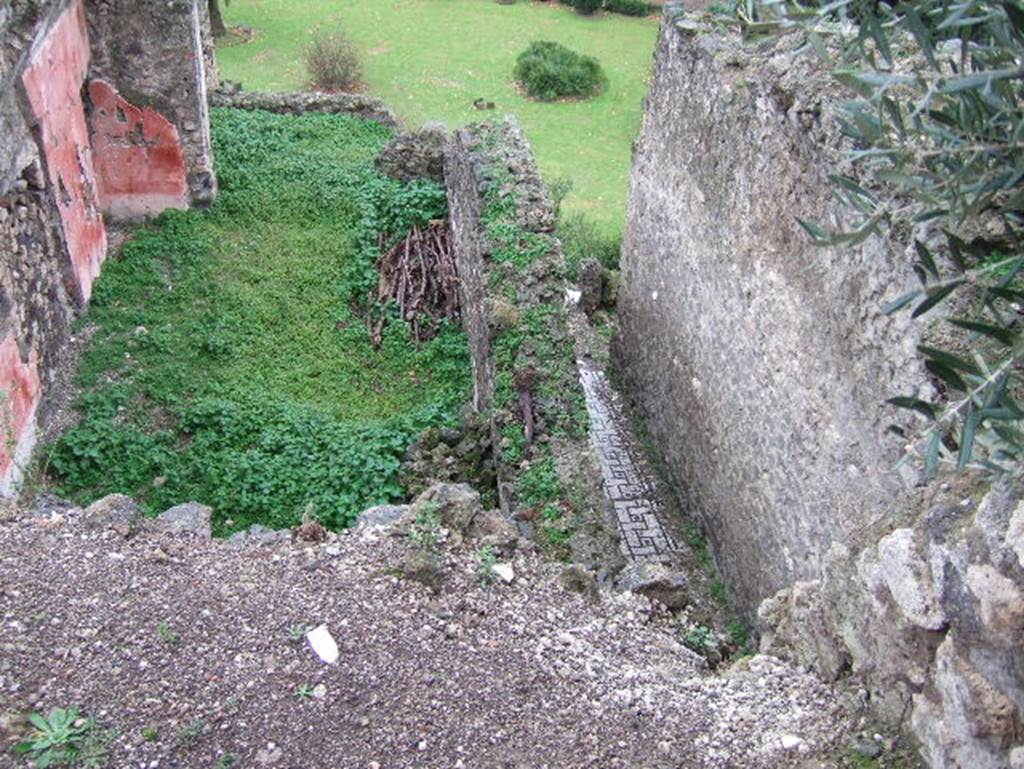
VIII.2.1 Pompeii, on right. December 2005.
Triclinium of VIII.2.3/VIII.2.16 (?) on the lower level 1, on left, with corridor 38 or (α), on lower level belonging to VIII.2.1, on right.
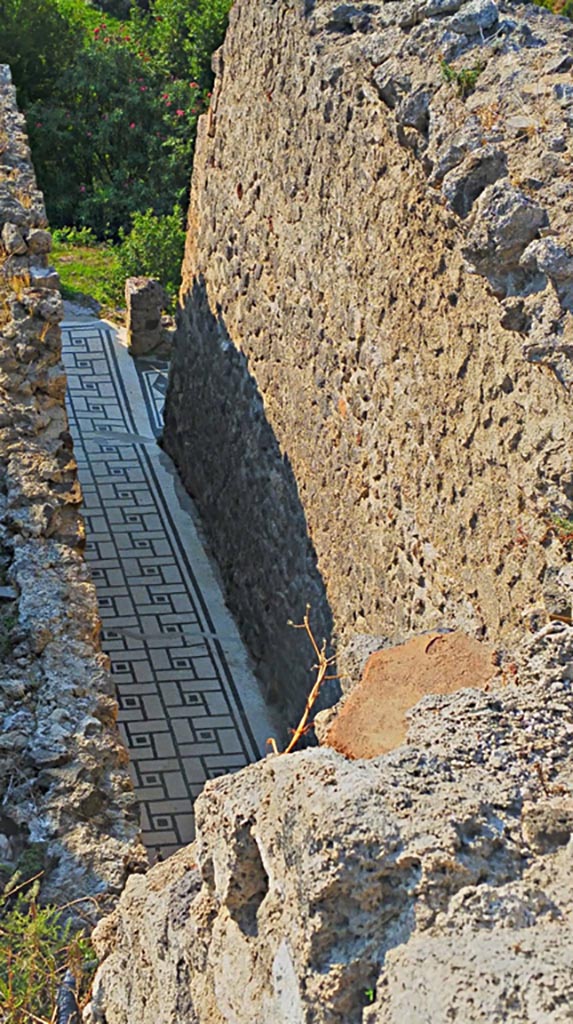
VIII.2.1 Pompeii. 2017/2018/2019.
Looking south along mosaic floor of corridor 38 or (α), on lower level 1.
The mosaic threshold of the doorway into the room 35 with oven, is on the west side of the south end.
Photo courtesy of Giuseppe Ciaramella.
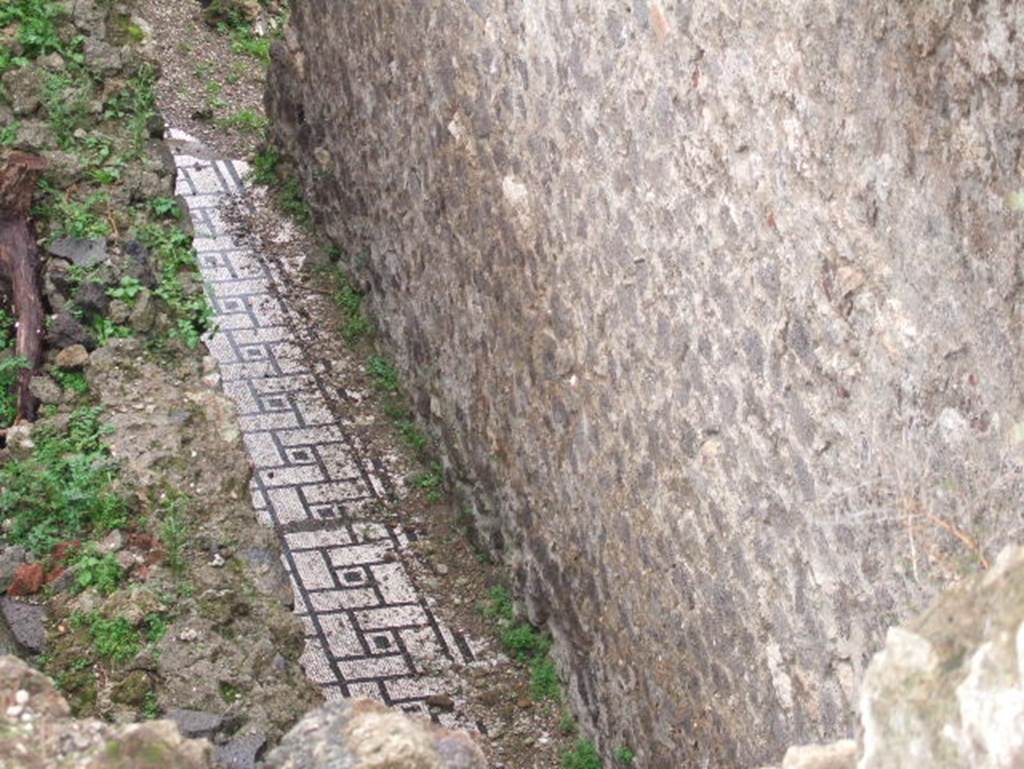
VIII.2.1 Pompeii. December 2005. Mosaic floor of corridor 38 or (α), on lower level 1.
According to Richardson –
“The
lower storey was once an arcaded court under the peristyle surrounded by a
vaulted passageway off which opened a few insignificant closets dug into the
bedrock to the north, while a fair-sized room opened off the stair of access a
little more than halfway down.
Presumably therefore, the large rooms to the
south of which only ruins remain were original parts of this storey.
In the last period the sunken court was
divided into four square rooms that did not communicate with one another but
only with the cryptoporticus, each given a barrel vault. These would have made
a cool retreat from the summer heat.
Beyond the south wing of the cryptoporticus,
facing the Sarno Valley a large vaulted room a half-storey lower than the
cryptoporticus was accessible by a sloping corridor opening out of the south-east
corner of the cryptoporticus.
This was certainly a triclinium for
banquets and had a wide door in its south wall commanding a view over the Sarno
Valley.
The other arrangements and rooms in this
wing are not clear, and the evidence has been confused by modern repairs and
rebuilding.
A very few remains of Third Style decoration
survive in dependencies of the arcaded lower court, while the atrium and almost
all the rooms around it, including the tablinum, the little dining room, and
the great new triclinium in the lowest storey of the terrace, have remains of
Fourth Style painting.”
See Richardson, L., 1988. Pompeii: An Architectural History. Baltimore: John Hopkins University Press, p. 234.
Part 1 Part 2
Part 3 Part 4
Part 5 Part 6